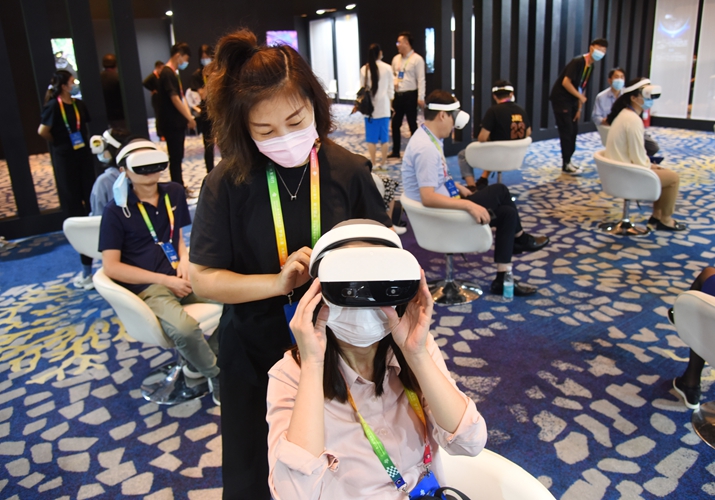| Business |
| Greater media-tech integration post-COVID-19 comes with caution from experts | |
|
|
 Visitors watch a virtual reality movie at a film and TV expo in Qingdao, Shandong Province in east China, on September 26 (XINHUA)
Live-streaming, real-time app push notifications, video meetings... under the impact of the novel coronavirus disease (COVID-19), both media outlets and technology developers have gained a deeper awareness of the new ways people are acquiring and exchanging information.
At a forum last month, leading media providers and tech firms in China underlined the importance of further cooperation to cope with the changes taking place in the two industries. Experts and representatives from the industries and the government shared their insights on media-tech integration during the two-day 2020 China Internet Media Forum held in Shanghai. During the COVID-19 epidemic, media outlets in China acted rapidly to provide information, offering access to real-time COVID-19 dashboards, sending health tips via mobile phones, and sharing stories of those fighting COVID-19 on the frontline via live-streaming and short-video apps. Using new technologies, online media platforms fought the virus in their own way, helping with the scientific and targeted nature of the COVID-19 response, Baidu CEO Robin Li said at the forum. Baidu and other Internet companies forecast a trend of deeper integration between the media and newer technologies. Artificial intelligence (AI) and 5G will reshape relations between audiences, media and information, Tencent CEO Pony Ma said in a pre-recorded speech. By developing information infrastructure for 5G, AI, big data and cloud computing, China has provided a sound environment for the Internet media industry, Liu Liehong, Vice Minister of Industry and Information Technology, said. China now has over 500,000 5G base stations, with 130 million terminals. New technologies will help media collect, transmit and process information, and diversify their methods to convey information, Liu said. When people stayed at home during the epidemic, they spent more time online. Tencent launched online visiting services for the Dunhuang Mogao Grottoes, a renowned UNESCO World Heritage Site in Gansu Province in northwest China. The services led to nearly 20 million e-visits in six months. With the evolution of technologies, online retailing has also embraced new changes. According to a report released by the China Internet Network Information Center in April, the number of live-streamers in China hit 560 million by March, accounting for more than 60 percent of Chinese netizens. The number of e-commerce live-streamers was 265 million, higher than the numbers of game-streaming, sports-related live-streaming, or live concert viewers. Xiaohongshu, an Instagram-like Chinese fashion- and lifestyle-sharing platform with about 120 million monthly active users, has developed a new business model through live broadcasting. "Live-streaming on our platform enabled many physical stores to access customers online during the epidemic," Miranda Qu, co-founder of Xiaohongshu, said. During a shopping festival held in Shanghai in May and June to stimulate spending, Xiaohongshu launched a live-streaming campaign to help stores in Shanghai showcase their products online. As a result, the customer traffic of shops in TX Huaihai, a shopping mall in central Shanghai, increased 400 percent on average. Over 10 million live-streaming shopping events were held during the first half of 2020, with more than 400,000 influencers taking part, according to data released by the Ministry of Commerce. Yet alongside the increasing popularity of Internet media, there were new worrying signs too. Li warned of the risks of relying too much on technologies, which might lead users into "a narrower world" of information. Algorithms should interpret users' higher-class demands, rather than simply following people's likes, he said. After COVID-19, tech firm Sina adjusted its algorithms to ensure that more reliable and useful epidemic-related information could reach its users. People are eager to get reliable information from the authorities during public emergencies, Sina's Wang Wei said, stressing that those managing algorithms must practice social responsibility. A healthy Internet should be an ecosystem that combines the aspirations of netizens, the concerns of the government, the responsibilities of the platforms, as well as societal participation, Ma said. "If media platforms seek only profit and try to attract views by hook or by crook, they will never go far," Zheng Yongnian, a scholar with the Chinese University of Hong Kong (Shenzhen), said. (This is an edited version of an article published by Xinhua News Agency) Copyedited by Sudeshna Sarkar Comments to yanwei@bjreview.com |
|
||||||||||||||||||||||||||||||
|
